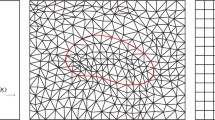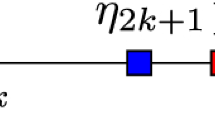Abstract
The non-conforming immersed finite element method (IFEM) developed in Li et al. (Numer Math 96:61–98, 2003) for interface problems is extensively studied in this paper. The non-conforming IFEM is very much like the standard finite element method but with modified basis functions that enforce the natural jump conditions on interface elements. While the non-conforming IFEM is simple and has reasonable accuracy, it is not fully second order accurate due to the discontinuities of the modified basis functions. While the conforming IFEM also developed in Li et al. (Numer Math 96:61–98, 2003) is fully second order accurate, the implementation is more complicated. A new symmetric and consistent IFEM has been developed in this paper. The new method maintains the advantages of the non-conforming IFEM by using the same basis functions but it is symmetric, consistent, and more important, it is second order accurate. The idea is to add some correction terms to the weak form to take into account of the discontinuities in the basis functions. Optimal error estimates are derived for the new symmetric and consistent IFE method in the \(L^2\) and \(H^1\) norms. Numerical examples presented in this paper confirm the theoretical analysis and show that the new developed IFE method has \(O(h^2)\) convergence in the \(L^\infty \) norm as well.









Similar content being viewed by others
References
Anderson, E., Bai, Z., Bischof, C., Blackford, S., Demmel, J., Dongarra, J., Du Croz, J., Greenbaum, A., Hammarling, S., McKenney, A., Sorensen, D.: LAPACK Users’ Guide, 3rd edn. Society for Industrial and Applied Mathematics, Philadelphia, PA (1999)
Babuška, I.: The finite element method for elliptic equations with discontinuous coefficients. Computing 5, 207–213 (1970)
Bramble, J., King, J.: A finite element method for interface problems in domains with smooth boundaries and interfaces. Adv. Comput. Math. 6, 109–138 (1996)
Brenner, S., Scott, L.: The Mathematical Theory of Finite Element Methods, vol. 15. Springer, Berlin (2008)
Camp, B., Lin, T., Lin, Y., Sun, W.: Quadratic immersed finite element spaces and their approximation capabilities. Adv. Comput. Math. 24, 81–112 (2006)
Chan, K., Zhang, K., Liao, X., Zou, J., Schubert, G.: A three-dimensional spherical nonlinear interface dynamo. Astrophys. J. 596, 663–679 (2003)
Chen, Z., Zou, J.: Finite element methods and their convergence for elliptic and parabolic interface problems. Numer. Math. 79, 175–202 (1998)
Chou, S., Kwak, D., Wee, K.: Optimal convergence analysis of an immersed interface finite element method. Adv. Comput. Math. 33, 149–168 (2010)
Di Pietro, D.A., Ern, A.: Mathematical Aspects of Discontinuous Galerkin Methods, vol. 69. Springer, Berlin (2012)
Fries, T., Belytschko, T.: The extended/generalized finite element method: an overview of the method and its applications. Int. J. Numer. Methods Eng. 84, 253–304 (2010)
Gong, Y., Li, B., Li, Z.: Immersed-interface finite-element methods for elliptic interface problems with non-homogeneous jump conditions. SIAM J. Numer. Anal. 46, 472–495 (2008)
Han, H.: The numerical solutions of the interface problems by infinite element methods. Numer. Math. 39, 39–50 (1982)
Hansbo, A., Hansbo, P.: An unfitted finite element method, based on Nitsche’s method, for elliptic interface problems. Comput. Methods Appl. Mech. Eng. 191, 5537–5552 (2002)
He, X., Lin, T., Lin, Y.: Approximation capability of a bilinear immersed finite element space. Numer. Methods Partial Differ. Equ. 24, 1265–1300 (2008)
He, X., Lin, T., Lin, Y.: Immersed finite element methods for elliptic interface problems with non-homogeneous jump conditions. Int. J. Numer. Anal. Model. 8, 284–301 (2011)
He, X., Lin, T., Lin, Y.: The convergence of the bilinear and linear immersed finite element solutions to interface problems. Numer. Methods Partial Differ. Equ. 28, 312–330 (2012)
Hou, S., Li, Z., Wang, L., Wang, W.: A numerical method for solving elasticity equations with interfaces. Commun. Comput. Phys. 12, 595–612 (2012)
Hou, S., Liu, X.: A numerical method for solving variable coefficient elliptic equation with interfaces. J. Comput. Phys. 202, 411–445 (2005)
Hou, T., Wu, X., Zhang, Y.: Removing the cell resonance error in the multiscale finite element method via a Petrov–Galerkin formulation. Commun. Math. Sci. 2, 185–205 (2004)
Huang, J., Zou, J.: Some new a priori estimates for second-order elliptic and parabolic interface problems. J. Differ. Equ. 184, 570–586 (2002)
Ji, H., Chen, J., Li, Z.: Augmented immersed finite element methods for elliptic PDEs with interfaces and irregular domains. Int. J. Comput. Math. (submitted)
Kafafy, R., Lin, T., Lin, Y., Wang, J.: Three-dimensional immersed finite element methods for electric field simulation in composite materials. Int. J. Numer. Methods Eng. 64, 940–972 (2005)
Kwak, D., Wee, K., Chang, K.: An analysis of a broken \(P_1\)-nonconforming finite element method for interface problems. SIAM J. Numer. Anal. 48, 2117–2134 (2010)
LeVeque, R., Li, Z.: The immersed interface method for elliptic equations with discontinuous coefficients and singular sources. SIAM J. Numer. Anal. 31, 1019–1044 (1994)
Li, Z.: A fast iterative algorithm for elliptic interface problems. SIAM J. Numer. Anal. 35, 230–254 (1998)
Li, Z.: The immersed interface method using a finite element formulation. Appl. Numer. Math. 27, 253–267 (1998)
Li, Z., Ito, K.: Maximum principle preserving schemes for interface problems with discontinuous coefficients. SIAM J. Sci. Comput. 23, 1225–1242 (2001)
Li, Z., Ito, K.: The immersed interface method: numerical solutions of PDEs involving interfaces and irregular domains. Frontiers in Applied Mathematics, vol. 33. SIAM, Philadelphia (2006)
Li, Z., Lin, T., Lin, Y., Rogers, R.: An immersed finite element space and its approximation capability. Numer. Methods Partial Differ. Equ. 20, 338–367 (2004)
Li, Z., Lin, T., Wu, X.: New Cartesian grid methods for interface problems using the finite element formulation. Numer. Math. 96, 61–98 (2003)
Lin, T., Lin, Y., Rogers, R., Ryan, M.: A rectangular immersed finite element space for interface problems. Adv. Comput. Theory Pract. 7, 107–114 (2001)
Lin, T., Lin, Y., Sun, W.: Error estimation of a class of quadratic immersed finite element methods for elliptic interface problems. Discret. Contin. Dyn. Syst. Ser. B 7, 807–823 (2007)
Lin, T., Zhang, X.: Linear and bilinear immersed finite elements for planar elasticity interface problems. J. Comput. Appl. Math. 236, 4681–4699 (2012)
Massjung, R.: An unfitted discontinuous Galerkin method applied to elliptic interface problems. SIAM J. Numer. Anal. 50, 3134–3162 (2012)
Mu, L., Wang, J., Wei, G., Ye, X., Zhao, S.: Weak Galerkin methods for second order elliptic interface problems. J. Comput. Phys. 250, 106–125 (2013)
Wang, X., Liu, W.K.: Extended immersed boundary method using FEM and RKPM. Comput. Methods Appl. Mech. Eng. 193, 1305–1321 (2004)
Wu, H., Xiao, Y.: An Unfitted \(hp\)-Interface Penalty Finite Element Method for Elliptic Interface Problems. arXiv:1007.2893 (2010)
Xie, H., Ito, K., Li, Z., Toivanen, J.: A finite element method for interface problems with locally modified triangulation. Contemp. Math. 466, 179–190 (2008)
Xu, J.: Error estimates of the finite element method for the 2nd order elliptic equations with discontinuous coefficients. J. Xiangtan Univ. 1, 1–5 (1982)
Yang, X., Li, B., Li, Z.: The immersed interface method for elasticity problems with interface. Dyn. Contin. Discret. Impuls. Syst. Ser. A Math. Anal. 10, 783–808 (2003)
Zhang, L., Gerstenberger, A., Wang, X., Liu, W.K.: Immersed finite element method. Comput. Methods Appl. Mech. Eng. 193, 2051–2067 (2004)
Acknowledgments
The authors would like to thank the anonymous referee for constructive comments. The first and second authors were supported by the National Science Foundation (NSF) of China (Grants Nos. 11371199 and 11301275), the Program of Natural Science Research of Jiangsu Higher Education Institutions of China (Grant No. 12KJB110013), and the Doctoral fund of Ministry of Education of China (Grant No. 20123207120001), and the Innovation Project for Graduate Education of Jiangsu Province (CXLX13_365). The third author was partially supported by the US ARO grants 550694-MA, the AFSOR grant FA9550-09-1-0520, the US NSF grant DMS-0911434, and the NIH grant 096195-01, and CNSF grants 11071123 and 11161036.
Author information
Authors and Affiliations
Corresponding author
Rights and permissions
About this article
Cite this article
Ji, H., Chen, J. & Li, Z. A Symmetric and Consistent Immersed Finite Element Method for Interface Problems. J Sci Comput 61, 533–557 (2014). https://doi.org/10.1007/s10915-014-9837-x
Received:
Revised:
Accepted:
Published:
Issue Date:
DOI: https://doi.org/10.1007/s10915-014-9837-x




